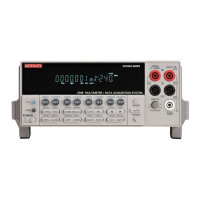Model 2700 Multimeter/Switch System User’s Manual Basic DMM Operation 3-33
Temperature measurements
The Model 2700 can measure temperature using thermocouples, thermistors, and 4-wire
RTDs. When deciding which temperature sensor to use, keep in mind that the
thermocouple is the most versatile, the thermistor is the most sensitive, and the 4-wire
RTD is the most stable.
Thermocouples
For thermocouples, temperature measurement range depends on which type of
thermocouple is being used. Thermocouples that are supported include types J, K, N, T, E,
R, S, and B.
When two wires made up of dissimilar metals are joined together, a voltage is generated.
The generated voltage is a function of temperature. As temperature changes, the voltage
changes. The thermocouple voltage equates to a temperature reading. This is the basic
operation principle of the thermocouple.
NOTE The equation to calculate thermocouple temperature is provided in Appendix F.
When you connect a thermocouple directly to the input of the Model 2700, at least one of
those connections will be a junction made up of two dissimilar metals. Hence, another
voltage is introduced and is algebraically added to the thermocouple voltage. The result
will be an erroneous temperature measurement.
To cancel the affects of the unwanted thermal voltage, the thermocouple circuit requires a
reference junction that is at a known temperature.
Type Range Resolution
J -200°C to 760°C 0.001°C
K -200°C to 1372°C 0.001°C
N -200°C to 1300°C 0.001°C
T -200°C to 400°C 0.001°C
E -200°C to 1000°C 0.001°C
R 0°C to 1768°C 0.1°C
S 0°C to 1786°C 0.1°C
B +350°C to 1820°C 0.1°C

